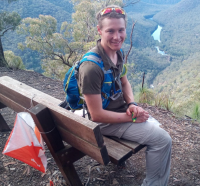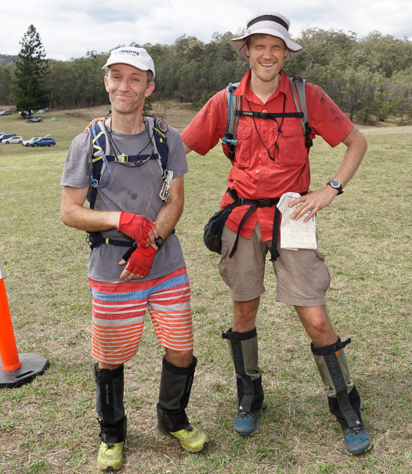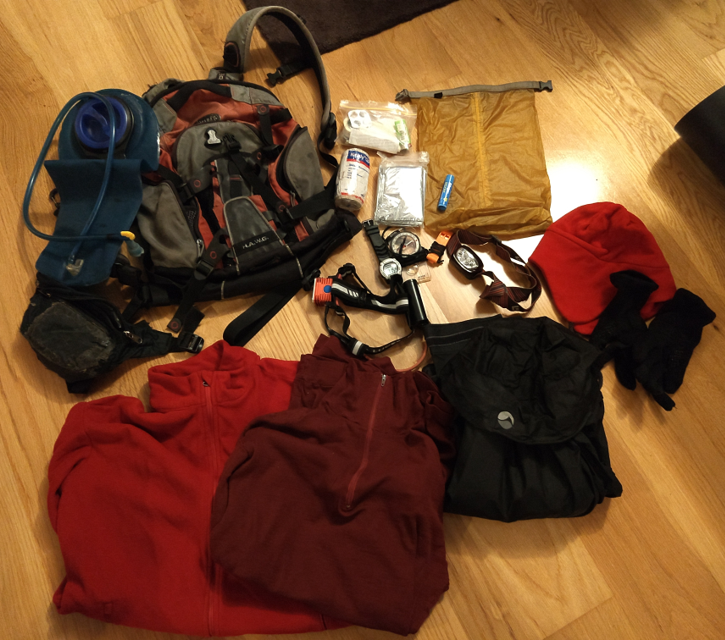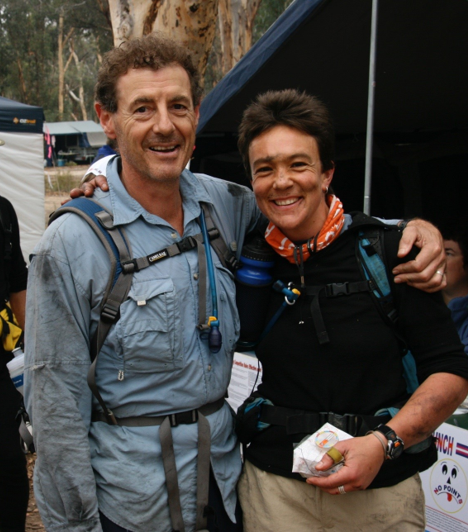
Whether it is the clothes you wear, the food you eat or the torch you carry, knowing the best gear to take with you on a rogaine is absolutely fundamental. It has been a long time since any NSW publication has discussed the best gear to carry on a rogaine, so this year I have decided to change that, with each newsletter having a “Gear of the Month” column that details a particular component of a rogainer’s kit, a couple of suggestions of models from long-time rogainers, and ways they can be used.
To kick off the series, I asked some of Australia’s most experienced rogainers what they would carry in a 24-hour rogaine.
David Williams, with Ronnie Taib, has won the NSW Championships for the last two years, so of course he is one of the prime targets to be questioned about what he carries. David kindly offered to share his strategies on gear.

Here’s David’s gear list for a standard 24hr Rogaine (excluding food… this will be covered later!)
Base Clothing:
- Quick dry cargo shorts – pockets are useful for food and rubbish on the go. Rarely cold enough for longs
- Quick dry button-up T-shirt with pockets
- Quick dry cap or brimmed hat
- Trail runners – light and breathable
- Free standing cordura/canvas gaiters (vent well from the top when left open)
- Synthetic moisture wicking socks
Additional Clothing:
- Long sleeve polypro top with zippered long neck. Merino is over-rated in my opinion.
- Light 100 weight fleece jacket (if cold weather forecast)
- Lightish weight Event rain jacket (if rain forecast)
- Lightweight fleece gloves – I get cold hands and find they make a big difference especially when trying to hold map and compass
- Fleece Beanie
First Aid/Emergency:
- Snake Bandage
- Pain Killers (paracetamol, ibuprofen)
- Band-Aids
- Dressings/gauze/tape
- Blister Pads
- Lighter
- Whistle
- Space Blanket
- Lip Balm
Other:
- 1 x Daymaker torch (a double cell Li-ion battery is enough for one night), 1 x lightweight spare torch
- 16L Camelbak + retro-fitted side bumbag for food on the go
- 3L Camelbak bladder
- Standard Silva Compass
- Weatherproof bag for spare clothes
Tristan White: What is changed or omitted in a shorter event?
David Williams: Generally the same would be carried for a 12hr event (albeit less food), however in a 6-hour I’d mostly ditch the warm gear, possibly the gaiters and of course the torch!

TW: What changes would you make to what you pack if more extreme weather is forecast?
DW: The only thing that changes between events (24 hrs) in terms of contents is clothing. I generally always carry a long sleeve thermal, beanie and gloves. If it’s going to be cold/wet then I’ll take a light weight fleece, a shell, and possibly a pair of thermal pants. If there’s negligible chance of rain/wind in the forecast I’ll drop the shell. If the temps are going to be warm I’ll drop the fleece.
Remoteness of the course and access to help (basically a road) also plays a role. If it’s a really remote course then I prefer to be a bit more self-sufficient should something go wrong and we have to stop.
TW: What items would you carry to the hash house and make a decision whether to wear/carry them right before the start?
DW: Warm clothes and wet weather gear. We rarely revisit the HH unless it fits very well with our course so most of the food we take tends to all go in at the start. Heavy at the start but we have more options and freedom in route choice.
TW: Is there anything “unusual” you take out on a course?
DW: After some bad Vaseline experiences I make my own anti-chafe, anti-prune lotion these days … lanolin, beeswax and tea tree oil. It’s worked very well so far with no foot issues at several very wet events including the World Champs last year. Lasts the distance too, and haven’t needed to reapply yet in a 24hr.
TW: What would you recommend paying the extra $’s for a good model of?
DW: Shoes – no piece of gear will cop it more! You won’t know what really works for you until you trial them at an event.
Queensland’s Richard Robinson describes himself as the World’s Greatest Rogaining Tragic. Since the early 1990’s he has done almost 180 rogaines, including 70x 24-hour’s, he is a former ARA President and was on the organising committee for the 2016 World Rogaining Championships. Richard also shared his gear of choice for a rogaine.
Base Clothing:
- Budgie smugglers under AR knicks with Earth, Sea Sky Taslan Longs over the top
- Long sleeved bushwalking shirt for sun protection & scratchy scrub
- Ventilated “baseball” style cap
- Adidas sports glasses with fully graduated transition lenses
- The North Face Trail Running Shoes
- Injinji “Cool Max” liners under Sockwa No Show Bamboo socks
- Cordura bushwalking gaiters
Additional Clothing:
- Long thermal top and bottoms – mainly used for an emergency (remember he is a Queenslander!)
- Light nylon spray/wind jacket
- Thermal inner gloves
- Buff
- No raincoat – getting wet is not a problem, it is about staying warm – I generally can stay warm if I keep moving. I’ve survived down to -7⁰C in a rogaine
First Aid/Emergency:
- Snake Bandage
- Space Blanket
- Strapping Tape
- Safety Pins
- Lube
- Antiseptic
Other:
- Spike Light + spare battery
- Macpac + 3L bladder
- 0.6L Electrolyte bottle
- Silva OMC wrist compass and Silva Raceplate compass
Tristan White: I see rogaine footwear ranging from trail running shoes to full fledged hiking boots with ankle supports. What are the advantages and disadvantages of the different footwear types?
Richard Robinson: I use trail running shoes because they give a good balance between robustness, protection and weight. I can understand that some people may prefer walking boots in heavy rock terrain like the 2016 WRC (Alice Springs) and the Flinders Ranges (2004 and 2012 ARC) but I don’t see the value. However I will only use shoes that have a Vibram sole (to prevent rock bruising of the soles of the feet), Gore-tex lining (to prevent penetration by spear grass seeds) and have impenetrable sides (to avoid sharp nasties like spinifex getting in).

TW: What conditions would you recommend gaiters be worn? Do you think that long pants can be sufficient leg protection when there is little overhanging scrub?
RR: If there is to be any serious off-track travel (pretty much every rogaine) then I use cordura or canvas gaiters, basically heavy duty bushwalking ones. Again this is heavily based on the spear grass issue but they resist most things (a bit of spinifex gets through but not much) and getting your ankles torn up on things like cutty grass or lantana (two more SE-Qld staples) will make your life miserable. This is one thing that you don’t get so much of in NSW.
TW: Do you have any opinions about the benefits of hiking poles, and what sort of rogainers would benefit by using them?
RR: Yes, there are some rogainers who use them, generally the more mature aged ones and generally only one pole as the map and compass also need to be carried. Since my left knee totally failed (it has since been replaced but the operation was only moderately successful) I have been carrying one pole on every 24-hour rogaine because I only have one properly functioning leg and it eventually gets a bit tired. The pole has never been out before the 22-hour mark and sometimes not come out at all. It helps with stability and motive force in steep and/or very rough terrain. In the last few years of my running career (I haven’t been able to run since 2014) I always used two poles in trail ultras and I always use them for multiday walks with a pack.
TW: Is it worth the extra weight to carry sleeping gear for a powernap and does the very rough rest actually help revive you?
RR: I have never slept out on the course in a rogaine but Tamsin and I did once in the Snowy Mountains in 2014 when she had returned on an overnight flight from Manila on the Wednesday night and needed a couple of naps. We just lay down for 20-30 minutes, one of them in a hut. I didn’t sleep, it was too cold, but she did. I would never consider carrying any sleeping gear, but then I would never consider sleeping either! In the 2006 WRC my partner demanded a nap and lay down for 20 minutes whilst I just sat there. We still won! In her defence it was snowing when she left Christchurch on the Thursday and it was mid-30’s on the Saturday of the event.
TW: What spare equipment do you take in a long rogaine?
RR: I carry a spare battery but not a spare light. If my partner has the same light we carry only one spare battery. In my first aid kit which I always carry I have; bandages, strapping tape and safety pins. I reckon that what you can’t fix with that will put you out of the race anyway. I am very minimalist.
Thank you Richard and David!
Stay tuned for the next Get into Gear series – “Hydration & Dealing with the Heat”